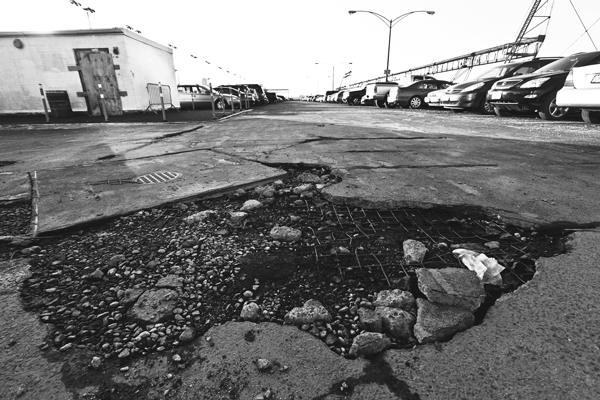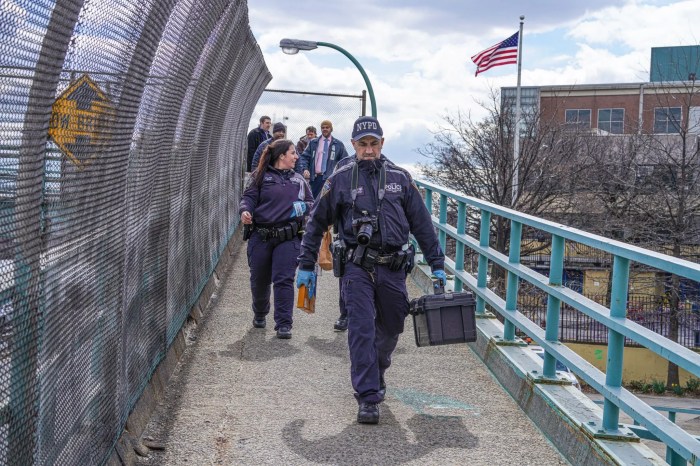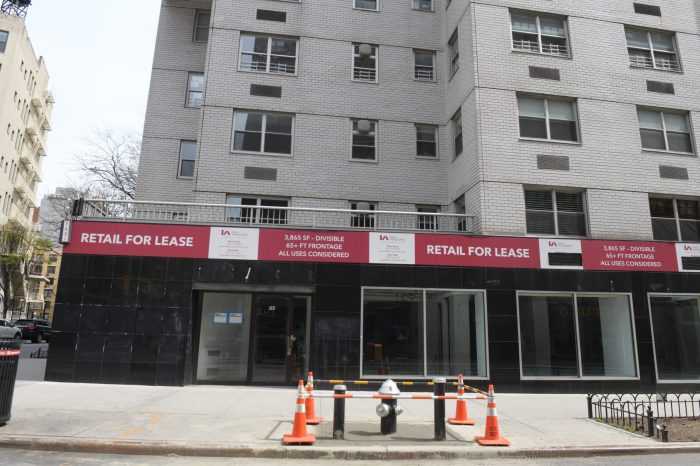 [/media-credit]
[/media-credit]
A skeptical-sounding Glick told the newspaper she’s concerned the Hudson River Park Trust is trying to “frighten and stampede” people into accepting residential use on the massive W. Houston St. pier. The park might well need some emergency repairs in spots, she acknowledged. But she said she’s concerned this is just a case of real estate developers trying to make a grab for Pier 40 while the grabbing’s still good during Mayor Bloomberg’s final years in office.
As The Villager first reported last week, a recently completed “Pier 40 Development Feasibility Study” by HR & A Advisors and Tishman/Aecom examined various development scenarios in terms of both revenue-generating potential and traffic impact on the pier, the park and the surrounding area.
The study was commissioned to “give direction” to the Trust on Pier 40, but the Trust isn’t recommending any specific plan for the pier yet.
Of the combinations of uses studied, the report found that adding 600,000 square feet of rental apartments (about 600 apartments), plus a 150-room hotel, to the 14.5-acre pier would yield the most revenue for the park, yet have the least traffic impact.
The housing would have to be rental because the Trust isn’t allowed to sell property. According to a source, rents would be high end — around $7,500. Bob Townley, director of Manhattan Youth, who saw the presentation, said the residential option featured massing studies with several 15-story towers or one 30-story tower. The lower of the two heights would be in line with Morton Square, a large residential development that’s near the pier and is about 15 stories tall.
The residential/hotel scenario would still have car parking, but somewhat less than the 1,400 parking spots currently in active use on the pier.
Not surprisingly, the study found that entertainment and destination retail uses were at the high end of the spectrum in terms of impact, in that they would generate the most visitor trips to the pier, comparatively speaking.
Pier 40 wouldn’t really be in demand for office space, the study concluded, since the site is located relatively far from transportation, plus across a highway.
The study is confidential. A few weeks ago it was presented to members of a community-based task force that is examining ways to increase financing for Pier 40 and Hudson River Park as a whole. However, task force members were not given copies of the report to keep.
Park needs funding
Hudson River Park is supposed to be self-financing, and Pier 40 has been generating about 40 percent of the park’s annual revenue. Yet city and state capital funding to complete the remaining 30 percent of the park’s construction has dwindled in recent years. In short, the Trust needs $200 million to complete the park.
Meanwhile, Pier 40 itself is crumbling and needs $100 million in repairs. Recently, the Trust found that Pier 54, at W. 13th St., is also in bad repair, and closed off 70 percent of it.
To allow residential and/or hotel use on Pier 40, the language of the 1998 Hudson River Park Act would have to be modified. The Trust also would like to be able to issue longer leases than permitted under the park act. Currently, it can only issue a 30-year lease for Pier 40, which isn’t long enough to make projects there viable for developers.
However, the Albany legislative session ends in June, leaving a very narrow time frame if these changes are to made during this year’s legislative session. The Trust, reportedly, and certain leading park advocates, are eager to see the changes made during this session.
Glick — whose district contains Pier 40 — is a key player and would need to be won over if there are to be any legislative changes.
Glick: Follow the law
The assemblymember emphasized that, in her understanding, according to the park legislation, a public hearing must be held for major changes proposed for the park — with 30 days’ prior notice given — followed by another 30 days for public comment.
“The Trust has painted a dramatic picture of the pier falling into the water, although it turns out that wouldn’t happen for years to come,” Glick said. “My concern is that they’re asking for dramatic changes, but don’t seem to have any plans for public hearings — and the legislation requires significant changes to be vetted through the public, not just a task force of 25 or 30 people.”
(For more of Glick’s thinking on the idea of residential use on Pier 40, see her talking point in this week’s issue, on Page 21.)
Arthur Schwartz, chairperson of the Hudson River Park Advisory Council, said, “I’m not sure that seeking legislative change requires the 30-day hearing.”
Schwartz e-mailed the relevant section of the park act:
In the case of any proposed significant action affecting the park or community, including the adoption of, and any amendment to, the general project plan or the annual financing plan, the trust shall: (a) hold a public hearing on not less than 30 days’ advance public notice; (b) solicit and consider the views of Manhattan community boards one, two, and four, the planning commission of the city of New York, the advisory council, elected officials representing communities neighboring the park, and interested groups and individuals, allowing not less than sixty days following the notice of the proposed action for the submission of such views.
“I don’t think a request for legislation is a ‘significant action’ under the law,” Schwartz said. “Nevertheless, the Trust has asked the advisory council to hold a public meeting, in conjunction with the three community boards, to react to the recommendations of the task force.”
Meeting in a few weeks
That public meeting — on proposed park changes, including for Pier 40 — will be at the end of this month or early next month on a date still to be determined.
Vivian Liao, a Trust spokesperson, said, “The Trust is working to schedule a public meeting, not a public hearing. The New York State Legislature does not require that a public hearing be conducted before it can act. If in the future, the Trust decides to amend the park’s General Project Plan in order to allow a use or other activity that was not previously contemplated, that juncture would be the trigger for a significant action hearing pursuant to the park act.”
Lee Alman, another Trust spokesperson, added that the key point is that state Legislature can make changes to the park act without a “significant action hearing” being held first. If the park legislation were to be changed — say, to allow residential use — and then the Trust actually decided to move forward on the idea of adding housing in the park, that would require a hearing, he said.
“The ideas the Trust is discussing with the Legislature are about tools they want in their toolbox, for lack of a better metaphor,” Alman said. If the Trust then decided actually to use any of these new “tools” — longer leases, bonding authority, removing building restrictions — only then would a “significant action hearing” be triggered, he added. Alman said the purpose of the advisory council meeting in a few weeks will be to discuss all these issues.
Schwartz is also chairperson of Board 2’s Waterfront Committee, which will be discussing the new developments regarding Pier 40 and the park.
“I have also added the issue to the May 21 Community Board 2 Waterfront Committee meeting, so that C.B. 2 can pass a resolution on the issues at its May 24 full-board meeting,” Schwartz noted.
Squadron weighs in
As for the state Senate, the pier is in Daniel Squadron’s district. The idea of the G.O.P.-led state Senate rejecting a plan to build market-rate housing in the park — or anywhere, for that matter — doesn’t seem likely. But Squadron says his position has traditionally been against such an idea.
“I’ve long been opposed to housing in a park to fund a park,” Squadron said. “Last summer I negotiated a first-of-its-kind agreement to fund Brooklyn Bridge Park based on the increased property values around the park. Whatever the conclusion, this is the time for creative thinking to ensure the long-term viability of Hudson River Park.”
Stadium still kicking around
In addition, about a month ago, representatives of Major League Soccer gave Trust officials and the task force a presentation of the league’s proposal for a 25,000-seat stadium on Pier 40.
Schwartz said he may ask MLS to give a presentation next month to the advisory council — which has a partial overlap with the task force in terms of its members.
(The soccer stadium scenario wasn’t analyzed in the Pier 40 study because the MLS pitch to the Trust and the task force came sometime after the Pier 40 study was already underway. However, the “impact” of the stadium on Saturday evenings during soccer season would clearly be off the charts.)
Although it’s not clear that the soccer stadium has much local support, it does have political clout behind it. Emily Giske — vice chairperson of the New York State Democratic Committee and a close friend of Council Speaker Christine Quinn — is a lobbyist for the MLS plan. However, Schwartz assured he’s not being pushed to allow the soccer group to present to the advisory council.
“No one is pressuring me,” he stated.
‘Cast a wide net’
An approach of “cast as wide a net as possible for potential uses” for the Pier 40 study was encouraged by the three local youth sports organizations that funded the initiative — Pier, Park and Playground Association (P3), Greenwich Village Little League and Downtown United Soccer Club.
Saving the pier’s sports fields is critical to the leagues. Under the residential/hotel scenario, 70 to 80 percent of the pier’s footprint would be covered by playing fields.
For his part, Brad Hoylman, C.B. 2 chairperson, agrees with the idea of looking at all possible uses. Asked what he thinks of the concept of residential/hotel use on Pier 40 and whether the park act’s restrictive language should be modified to allow it, Hoylman said, “Everything needs to be on the table at this point. It’s a complicated issue that will require a great deal of input from the local community, advocates and our local elected officials.”
Other revenue raisers
Another change the Trust reportedly wants concerns Pier 76, the 4-acre pier at W. 36th St. near the Javits Center, where the Police Department tow pound is now located.
“The Hudson River Park Act said the N.Y.P.D. needed to make best efforts to remove the tow pound at Pier 76,” spokesperson Liao said. “The park was to receive half of the pier, and half was to be developed commercially for the city. We are asking for the entire pier to come to the Trust and that any revenue generated go toward maintenance and operations of the park.”
In addition, the Trust would like to be allowed to issue tax-exempt bonds, which would let it borrow money, creating a stable income for park repairs. Again, a legislative change would be needed.
Yet another revenue-generating idea for the park is a “park improvement district,” along the lines of a business improvement district, or BID. This hybrid “PID” would extend out from the park two or three blocks into the surrounding neighborhoods; it would provide supplementary services, such as tending the West Side Highway median, for one, which is in sore need of some upkeep. Property owners would be assessed a small tax to fund the “PID.” City Council approval would be required to authorize the district’s formation.
A similar concept for a High Line improvement district failed a few years ago, after property owners and residents in Chelsea balked at the concept. However, the Friends of Hudson River Park, the park’s main private fundraising organization, is still behind the improvement district plan.
“The BID is still being explored, and the Friends of Hudson River Park continues to talk to property owners about the idea,” Liao said.

















